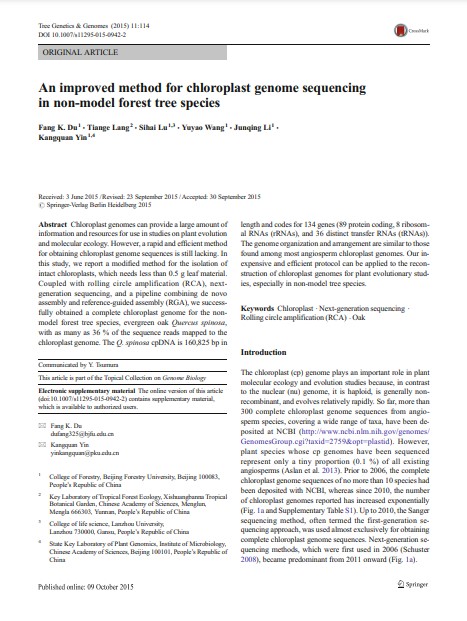An improved method for chloroplast genome sequencing in non-model forest tree species
Bosque Modelo:
Nova Forest Alliance
Temática:
Gestión forestal
Tipo de documento:
Artículo científico
Resumen
Chloroplast genomes can provide a large amount of information and resources for use in studies on plant evolution and molecular ecology. However, a rapid and efficient method for obtaining chloroplast genome sequences is still lacking. In this study, we report a modified method for the isolation of intact chloroplasts, which needs less than 0.5 g leaf material. Coupled with rolling circle amplification (RCA), nextgeneration sequencing, and a pipeline combining de novo assembly and reference-guided assembly (RGA), we successfully obtained a complete chloroplast genome for the nonmodel forest tree species, evergreen oak Quercus spinosa, with as many as 36 % of the sequence reads mapped to the chloroplast genome. The Q. spinosa cpDNA is 160,825 bp in length and codes for 134 genes (89 protein coding, 8 ribosomal RNAs (rRNAs), and 36 distinct transfer RNAs (tRNAs)). The genome organization and arrangement are similar to those found among most angiosperm chloroplast genomes. Our inexpensive and efficient protocol can be applied to the reconstruction of chloroplast genomes for plant evolutionary studies, especially in non-model tree species.Chloroplast genomes can provide a large amount of information and resources for use in studies on plant evolution and molecular ecology. However, a rapid and efficient method for obtaining chloroplast genome sequences is still lacking. In this study, we report a modified method for the isolation of intact chloroplasts, which needs less than 0.5 g leaf material. Coupled with rolling circle amplification (RCA), nextgeneration sequencing, and a pipeline combining de novo assembly and reference-guided assembly (RGA), we successfully obtained a complete chloroplast genome for the nonmodel forest tree species, evergreen oak Quercus spinosa, with as many as 36 % of the sequence reads mapped to the chloroplast genome. The Q. spinosa cpDNA is 160,825 bp in length and codes for 134 genes (89 protein coding, 8 ribosomal RNAs (rRNAs), and 36 distinct transfer RNAs (tRNAs)). The genome organization and arrangement are similar to those found among most angiosperm chloroplast genomes. Our inexpensive and efficient protocol can be applied to the reconstruction of chloroplast genomes for plant evolutionary studies, especially in non-model tree species.
Información Bibliográfica
Autor:
Du, Fang K.; Lang, Tiange; Lu, Sihai; Wang, Yuyao; Li, Junqing; Yin, Kangquan
Revista:
TREE GENETICS & GENOMES
Año:
2015
N°:
114
País :
Canadá
Páginas:
-
Volumen:
11
Idioma:
Ingles
Palabras claves
Chloroplast . Next-generation sequencing . Rolling circle amplification (RCA) . Oak





